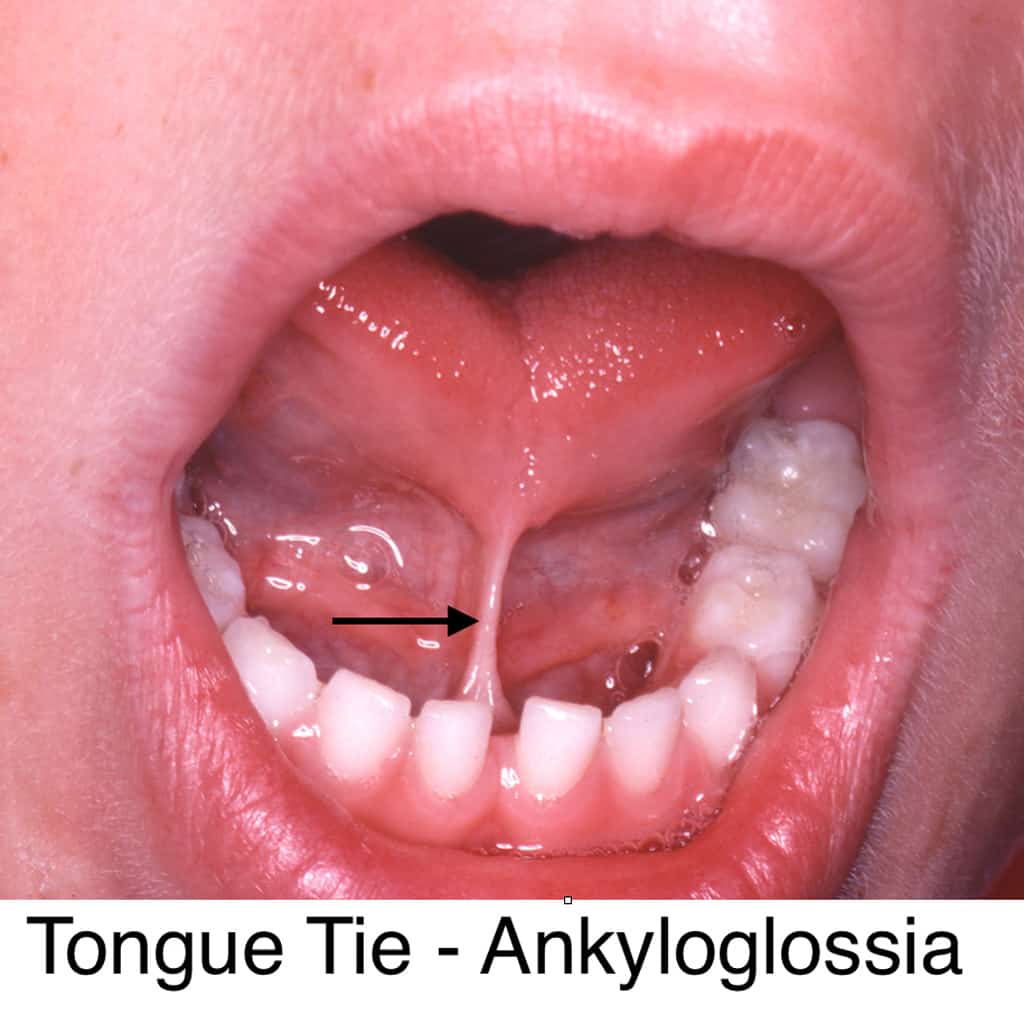About Tongue Ties?
Tongue tie, also known as ankyloglossia, is a condition that affects the movement of the tongue and is present at birth. It occurs when the frenulum, a small piece of tissue that connects the tongue to the floor of the mouth, is too short, tight, or thick. This can restrict the movement of the tongue and make it difficult to perform certain tasks, such as sticking out the tongue or moving it from side to side. In many cases there can be benefits to a tongue tie release procedure or frenuloplasty.

Growth and Development of the Jaws and Tongue Tie
The tongue plays a critical role in growth and development of the mouth buy putting pressure on the palate and dental arches. Tongue tie decreases this pressure and is associated with a small mouth, palate and dental arches. Tongue tie is usually seen in cases of crooked teeth and severe orthodontic problems. Tongue tie can cause problems with breastfeeding, speaking, and eating. Tongue tie is also associated with mouth breathing, teeth clenching and TMJ problems. When the tongue does not move properly the mouth does not grow as large as it should. Usually the palate does not widen enough and it is high-vaulted. A small palate is linked to poor nasal breathing and upper airway resistance problems.
Palatal Expanders and Myofunctional Therapy
Mouth breathing, airway problems, TMJ and orthodontic problems are best treated with a combination of palatal expanders, myofunctional therapy and breathing exercises. Some of our most popular kids expanders are Schwarz, ALF, Twinblock and Biobloc. Our most popular adult expanders are Homeoblock and DNA appliances. Posture is often compromised and a chiropractor or physical therapist may be helpful in the treatment process.
Tied tongue can also lead to issues with oral hygiene, as the tongue may not be able to reach all parts of the mouth to clean it properly. In some cases, tongue tie may be corrected with a simple procedure to release the frenulum, which is called a frenotomy. In most cases myofunctional therapy will be necessary to restore proper tongue posture and function.
Benefits of tongue tie release procedure
Different types of tongue ties:
Posterior tongue tie
This is the most common type of tongue tie and occurs when the frenulum is attached to the back of the tongue. A posterior tongue tie can cause problems with breastfeeding and speech, as the tongue may not be able to move freely enough to form certain sounds.
Anterior tongue tie
This type of tongue tie occurs when the frenulum is attached to the front of the tongue. Anterior tongue tie can cause problems with breastfeeding and eating, as the tongue may not be able to reach the roof of the mouth or move food around in the mouth effectively.
Mixed tongue tie
Mix tongue tie combines features of both posterior and anterior tongue tie, with the frenulum attaching to both the front and back of the tongue.
Lip tie
This is a type of tongue tie that affects the frenulum of the upper lip, causing problems with breastfeeding and speaking. A Lip tie connects the lip in a very tight way to the upper and lower jaw. Lip ties can impair nasal breathing and retrude the lower jaw.
Other articles about Myofunctional Therapy
Symptoms of tongue tie:
- Difficulty breastfeeding or maintaining a latch
- Mouth Breathing
- Teeth Clenching
- Poor Sleep
- Crowded and Crooked Teeth
- Bad Posture
- Inability to stick out the tongue past the lower lip
- Difficulty with certain sounds, such as “s” and “t”
- Problems eating certain foods, such as those that require chewing
- A tongue that appears notched or heart-shaped when sticking out
Laser Tongue Untie/Frenectomy Procedure:
Treatment for tongue tie may involve a simple procedure called a frenectomy. Frenectomies involve releasing the frenulum to allow the tongue to move more freely. This procedure is usually performed by a dentist or lactation consultant and can be done in the dentists office. Frenectomies are usually performed with a laser and hurt very little and cause minimal bleeding.
Tongue Untie and Palatal Expanders for Mouth Breathing
It’s important to note that not all cases of tongue tie require treatment, and some children may not experience any problems as a result of their tongue tie. However, if tongue tie is causing problems with breastfeeding, speaking, or eating, treatment may be necessary to improve the child’s quality of life. Additionally tongue tie can lead to crowded and crooked teeth and severe orthodontic problems. The tongue also plays a role in growth and development of the mouth and nasal passageways. Untying the tongue is part of palatal expansion treatment in adults and kids who have TMJ problems, airway resistance and mouth breathing issues.
The most popular palatal expanders for adults are the DNA appliance and Homeoblock device.
Tongue Tie Procedure Before and After
In conclusion, tongue tie is a condition that affects the movement of the tongue and is present at birth. It can cause problems with breastfeeding, speaking, and eating, and may be corrected with a simple procedure called a frenotomy. While not all cases of tongue tie require treatment, it is important to address any issues that may be affecting a child’s quality of life.

 703-712-1053
703-712-1053 